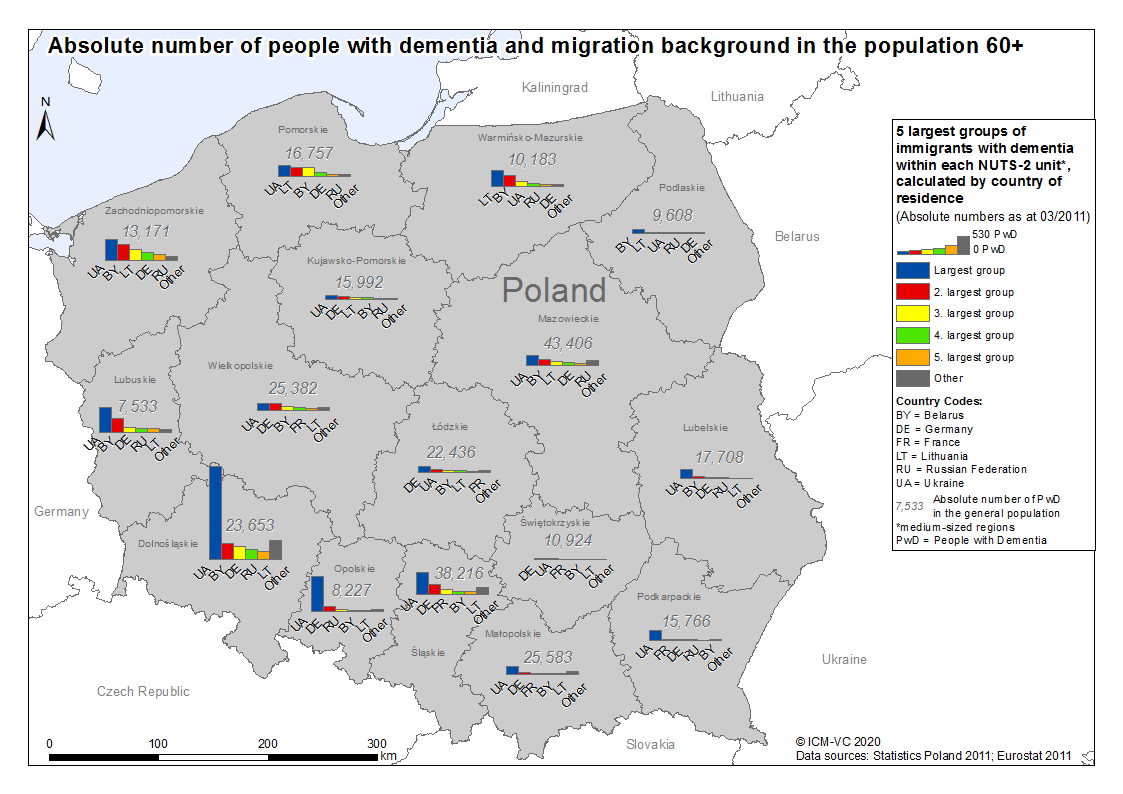EU-Atlas: Dementia & Migration
| Largest group | 2. largest group | 3. largest group | 4. largest group | 5. largest group | |
| Absolute numbers | |||||
| PwMD per 100,000 inhabitants 65+ |
| Absolute numbers | PwMD per 100,000 inhabitants 65+ | |
| Largest group | ||
| 2. largest group | ||
| 3. largest group | ||
| 4. largest group | ||
| 5. largest group |
| Prevalence per 100,000 inhabitants 65+*, calculated by country of residence | |||
|---|---|---|---|
| high > PwMD |
minor > - PwMD |
||
| increased > - PwMD |
low ≤ PwMD | ||
| medium > - PwMD |
|||
| PwMD = People with a Migration background with Dementia *Bulgarien, Litauen, Malta, Polen in der Bevölkerung 60+ |
|||
| Absolute number of PwMD 65+ | |
| PwMD per 100,000 inhabitants 65+ |
Poland
The history of Poland’s migration is characterised by emigration1. Economic emigration began at the end of the 19th century2. After the Second World War, between six and eight million people left Poland, most of them emigrating to Germany2,3. After the collapse of communism in 1989, transit migration and immigration from neighbouring eastern countries (Ukraine, Belarus, the Russian Federation) increased. As a result of EU accession on 1 May 2004, emigration to other EU states, especially to Great Britain and Ireland, has risen1,3. In 2013, people from Ukraine were the largest migrant group, followed by people from Germany, Belarus, Lithuania, and the Russian Federation4. Between 1990 and 2019, the migrant population (born abroad) and its share in the total population has almost halved (1.1 million to 656,000; 3 to 1.7%)5.
There are 437,200 people with a migration background aged 65 or older. Of those, approx. 17,300 are estimated to exhibit some form of dementia. Calculations show that the most affected migrant groups presumably originate from Ukraine (approx. 7,800), Belarus (approx. 2,700), Germany (approx. 2,100), Italy (approx. 1,900), and the Russian Federation (approx. 1,200)6.
For Poland, neither a national dementia plan nor a document with national care guidelines could be identified. However, in 2016 Poland published an 80-page report on the ‘The Situation of People With Alzheimer's Disease in Poland’. This report covers the topics epidemiology of Alzheimer's disease, disease pattern, methods of diagnosing Alzheimer's disease and other dementias, organisation of care for Alzheimer's patients, home care, treatment options for dementia, or the role of organisations reuniting families of patients among others. None of these topics is linked to people with a migration background7.
References
- Alscher S: Country Profile Poland. In. Edited by Hamburgisches WeltWirtschaftsInstitut, Bundeszentrale für politische Bildung; 2008.
- Koryś I: Poland: Dilemmas of a Sending and Receiving Country. In., vol. 3; 2004.
- Iglicka K, Ziolek-Skrzypczak M: EU Membership Highlights Poland's Migration Challenges. [https://www.migrationpolicy.org/article/eu-membership-highlights-polands-migration-challenges]. (2010). Accessed 05 May 2020.
- United Nations: Migration Profiles: Poland; 2013.
- International Organisation for Migration: International migrant stock as a percentage of the total population at mid-year 2019: Poland; 2019.
- Statistics Poland: Census 2011. In. Warsaw: Statistics Poland 2011.
- Szczudlik A, Barcikowska-Kotowicz M, Gabryelewicz T, Opala G, Parnowski T, Kuźnicki J, Rossa A, Sadowska A: The situation of people with Alzheimer's disease in Poland. In: Commissioner report. Edited by Szczudlik A. Warsaw; 2016.



![[Translate to Englisch:] Logo RBS [Translate to Englisch:] Logo RBS](/fileadmin/_processed_/9/7/csm_RBS_Logo_RGB_0e245a98a4.jpeg)